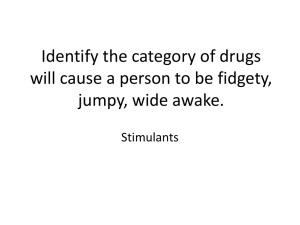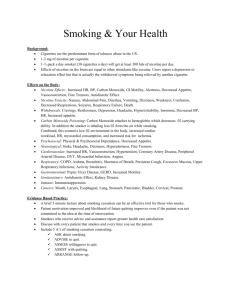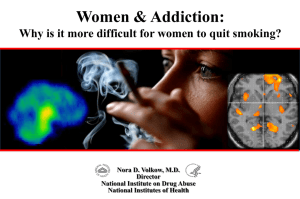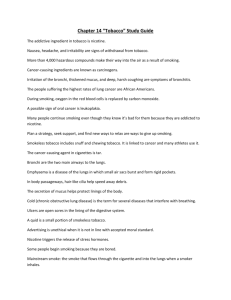Health-Enhancing Behaviours
advertisement
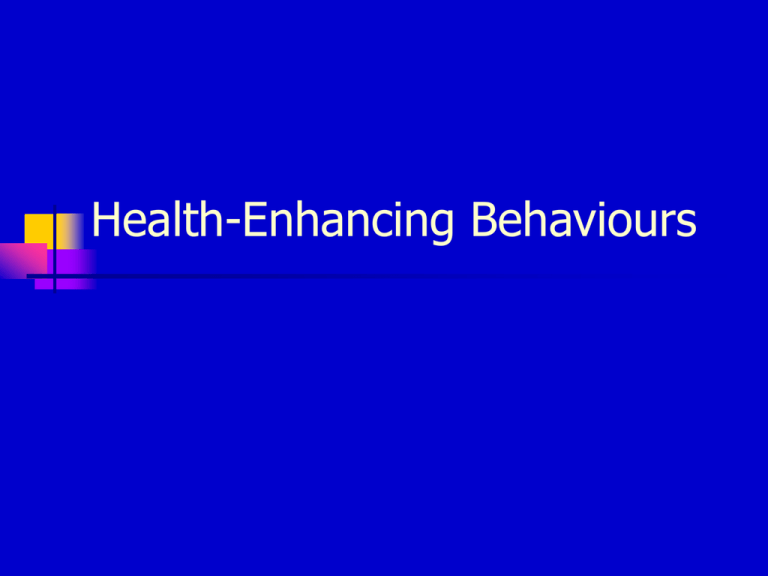
Health-Enhancing Behaviours Body Shape and Weight Concerns Studies suggest that as many as 80% of 10-year girls have been on a diet; 50% of girls between 14 and 18 years believe they are too fat; and 45% of 14 to 18 year old girls are dieting. DSM-IV Criteria – Anorexia Nervosa Refusal to maintain body weight at or above normal weight for age (i.e., weight loss or failure to gain weight resulting in weight < 85% of expected). Intense fear of weight gain or becoming fat. Disturbed body image, undue influence of weight on issues of self-worth, denial of seriousness of weight loss. Absence of at least 3 consecutive menstrual cycles. DSM-IV Criteria for Bulimia Nervosa (BN) Recurrent episodes of binge eating characterized by: Eating an abnormally large quantity of food in a discrete period of time; and A sense of lack of control over eating. Recurrent inappropriate compensatory behaviours (e.g., vomiting, laxatives, diuretics, enemas, fasting, vigorous exercise). The above two occur at least twice a week for at least 3 months. Self-evaluation unduly influenced by weight. Etiology of AN 10-15 times more frequent in women than men Evidence for genetics is inconistent Family variables include the child being over-controlled by parents. Sociocultural risk factors Eating Disorders Not a new disorder Anorexia nervosa (AN) first described in 1694 Bulimia nervosa (BN) first identified in 1892 Usual age of onset is adolescence or early 20s. 90% or more are females. Prevalence of AN is 0.5% to 1.0%. Prevalence of BN is 1.0 to 3.0%. Etiology of Bulimia Nervosa Bio-psychosocial model proposes that biogenetic predispositions, e.g., depression, combine with familial factors and sociocultural pressures, emphasizing high achievement and thinness, that promote a character structure featuring affective instability and low self-esteem. Etiology of BN continued Negative Self-Evaluation Characteristic extreme concerns about shape and weight Intense and rigid dieting Binge eating Purging Perfectionism and dichotomous thinking. Negative affect Referral Rates for AN and BN to Clarke Institute from 1975 - 1986 100 90 80 70 60 A N -re stric to r 50 40 30 20 10 0 BN 1986 1985 1984 1983 1982 1981 1980 1979 1978 1977 1976 1975 A N -b in g e Healthy Exercise 3 hours per week (across 3 – 5 sessions) Warm-up Aerobics Stretching and flexibility exercise Strength and endurance exercise Rhythmic exercise of large muscle groups Raise heart rate to moderately high level Cool down Why is exercise healthy? Three psychosocial benefits are: Feel less stressed and anxious Better work performance and attitudes More positive self-concept Physiological benefits Increased production of endorphins Improved agility Improved bone density Improved strength and flexibility Cardiovascular Benefits of Exercise Lowers systolic and diastolic blood pressure heart rate and thereby helps protect the heart against heart rhythm disturbances LDL-cholesterol and raises HDL-cholesterol (the good cholesterol) Potential Risks of Exercise Accidents Injuries Heart exhaustion and heat stroke May become addictive Precipitate a heart attack If using steroids to enhance exercise, number of adverse effects of steroids Who is more likely to exercise? Men Whites more than Hispanics and Blacks Young more than old Well educated or higher SES groups Previous exercise history Those who feel well Non-smoker Metropolitan Height & Weight Tables Women Small frame – 5’4” ideal weight is 114127 lbs. Medium frame – 5’4” ideal weight is 124138 lbs. Men Small frame – 6’ ideal weight is 149160 lbs Medium frame – 6’ ideal weight is 157170 lbs Who becomes overweight? About 40% become overweight In women, Blacks and Hispanics more likely to be overweight than Whites. Genetics and familial influences Prevalence increases with age Why do people gain weight? Biological factors – Lower metabolic rate Malfunctioning endocrine glands Heredity Set-point theory Your body tries to maintain set weight Thermostat-like mechanism Hypothalamus involved May relate to no. and size of fat cells Psychosocial Factors Eat more when stressed Alcohol – adds calories to diet and reduces disposal of fat Watching television may reduce metabolic weight rates below normal resting rates Health Hazard Weight Level Small risk – 10% over ideal weight Moderate risk – 20% over ideal weight Greatly increased risk – 50% over ideal Distribution of weight – more hazardous if concentrated around the abdomen Healthy Eating Eating nutritionally balanced meals Poor nutritional balance has been implicated as factor in many diseases: Colon, stomach, pancreatic, prostate, and breast cancer. Hypertension (salt and high body weight) Hypercholesterolemia (saturated fats) Diabetes (body weight, sugar, fats) Sleep Disorders Sleep Disorders Ideal is 7-8 hours a night Insufficient sleep can cause: Impaired cognitive functioning Mood disturbance Poor work performance Impaired immune functioning Poor sleep predicts higher mortality rates Health-Compromising Behaviours Smoking Substance Abuse Addiction – physical and psychological dependence on a substance following use over a period of time Physical dependence – body is use to the substance and incorporates the use of the substance in its normal function. Tolerance – increasing adaptation to the substance so that higher and higher doses need to achieve same result. Withdrawal – unpleasant physical and psychological symptoms upon withdrawal. Nicotine 22-25% of US smoke, similar rates are seen in Canada with regional variation. More than 80% of smokers started as youth. If people do not begin to smoke as youth unlikely they will start as adults. Nicotine reaches the brain within 7-15 seconds. Why Do People Smoke Age Culture Peer encouragement More likely if parents smoke Personality characteristics (rebellious, risk taker) Smokers image (e.g., cool, mature, glamorous, exciting) Reasons Given for Smoking (Silvan Thomkins) Positive affect – stimulation, relaxation, pleasure Negative affect – relieves boredom, stress, depression Habitual – behaviour becomes a habit Psychological dependence – use it to regulate emotions Nicotine – Maintaining Factors Physical addiction Physical habit Emotional support Personal identity Social habit Cigarette smoke contains Carbon monoxide – gas that is readily and rapidly absorbed into bloodstream affecting physical functioning Tars – minute particles of residue – adverse health effects but not related to addictive effect Nicotine – addictive chemical in tobacco Nicotine Penetrates cell membranes in nose, mouth, lungs, and blood Blood rapidly carries nicotine to the brain (within 7 sec) Brain releases various chemicals that activate both the central and sympathetic nervous system Increase arousal, alertness, attention, heart rate, and blood pressure Nicotine levels decrease rapidly Nicotine-Regulation Model Smoke to maintain a certain level of nicotine Smoke to avoid symptoms of withdrawal Addiction not all due to biochemical effects since cravings can continue long after physical addictive effects are gone (up to 5 years) Bio-Behavioural Model Continue smoking to regulate cognitiveemotional state Control weight Nicotine affects chemicals in the brain (acetycholine, norepinephrine) that increase alertness and decrease tension (and withdrawal symptoms) Relapse 50 – 80% of those who quit relapse within a year Stress is primary reason for relapse (smoking seen to help stress) Social support helps protect against relapse Self-efficacy is most important factor in quitting Abstinence-violation Effect Tendency to start smoking again after a lapse because of reduced self-efficacy for quitting and reminder about positive effects of smoking. Weight-gain often leads to relapse so as to control weight. Caloric intake increases. Metabolism decreases. Transtheoretical Model (Prochaska & DiClemente, 1992) Preparation Contemplation Action Precontemplation Maintenance Relapse Processes of Change Prochaska et al. 1992 Precontemplation Contemplation Preparation Action Consciousness raising Maintenance Reinforcement management Dramatic relief Selfre-evaluation Selfliberation Helping relationships Environmental re-evaluation Pros & cons Trial & error Counterconditioning Stimulus control Stage-Based Intervention for Smoking Cessation: Prochaska, et al., 1993 Objective: To compare four self-help programs for smoking cessation in general population of smokers. Stage-Based Intervention for Smoking Cessation: Prochaska, et al., 1993 Subject recruitment: Subjects were 755 volunteers in Rhode Island who responded to a newspaper advertisement seeking participants to test self-help materials developed for smokers in various stages of change. Stage-Based Intervention for Smoking Cessation: Prochaska, et al., 1993 Interventions: Standard manuals from American Lung Association (ALA) TTM-based Manuals (TTM) Interactive computer assessment and tailored interventions to stage of change (ITTM) Interactive computer assessment, tailored interventions, and counsellor calls (CITTM) Prochaska et al., 1993 Cessation Rates 30% 25% 20% ALA TTM 15% ITTM 10% CITTM 5% 0% P re P < 0.05 6 m o. 12 m o. 18 m o. Assessment Points (Months) Alcohol – Who Drinks? Drinking usually begins in high school Males drink more but gender gap lessening White more than Hispanics who are more than blacks Higher rates amongst Natives, lower in Asians 60% drink occasionally Problem Drinking Drinks heavily on a regular basis Psychologically dependent Social and/or occupational impairment 13% of drinkers have a problem Of these, ¾ are male Alcoholics About ½ of problem drinkers Physically dependent on alcohol High tolerance for alcohol May suffer black outs and memory losses Experience delirium tremors from withdrawal (anxiety, agitation, hallucination, tremors) Alcohol Dependence/Abuse Lifetime prevalence is about 10% in women and 20% in men. 75% of car accidents at night are due to drinking. Alcohol-related disorders are associated with 50% of homicides and 25% of suicides. Genetic link – family history associated with 3-4 times greater risk as well as being associated with more serious alcohol-related problems. Alcohol Dependence/Abuse – Clinical Course Most exhibit their first alcohol-related problem in late 20s and 30’s. Most first present for treatment in their 40s. Die about 15 years earlier than nonalcoholic. Course of alcohol abuse is fluctuating. Spontaneous remission in 10-30%. Health Risks from Heavy Alcohol Use Accidents (alcohol use accounts for the majority of traffic accidents in youth & 50% of traffic accidents of all ages) Cirrhosis of the liver Some forms of cancer Fetal alcohol syndrome in new-born Retardation and physiological abnormalities in offspring of mothers who drink Cognitive impairment Brain damage





